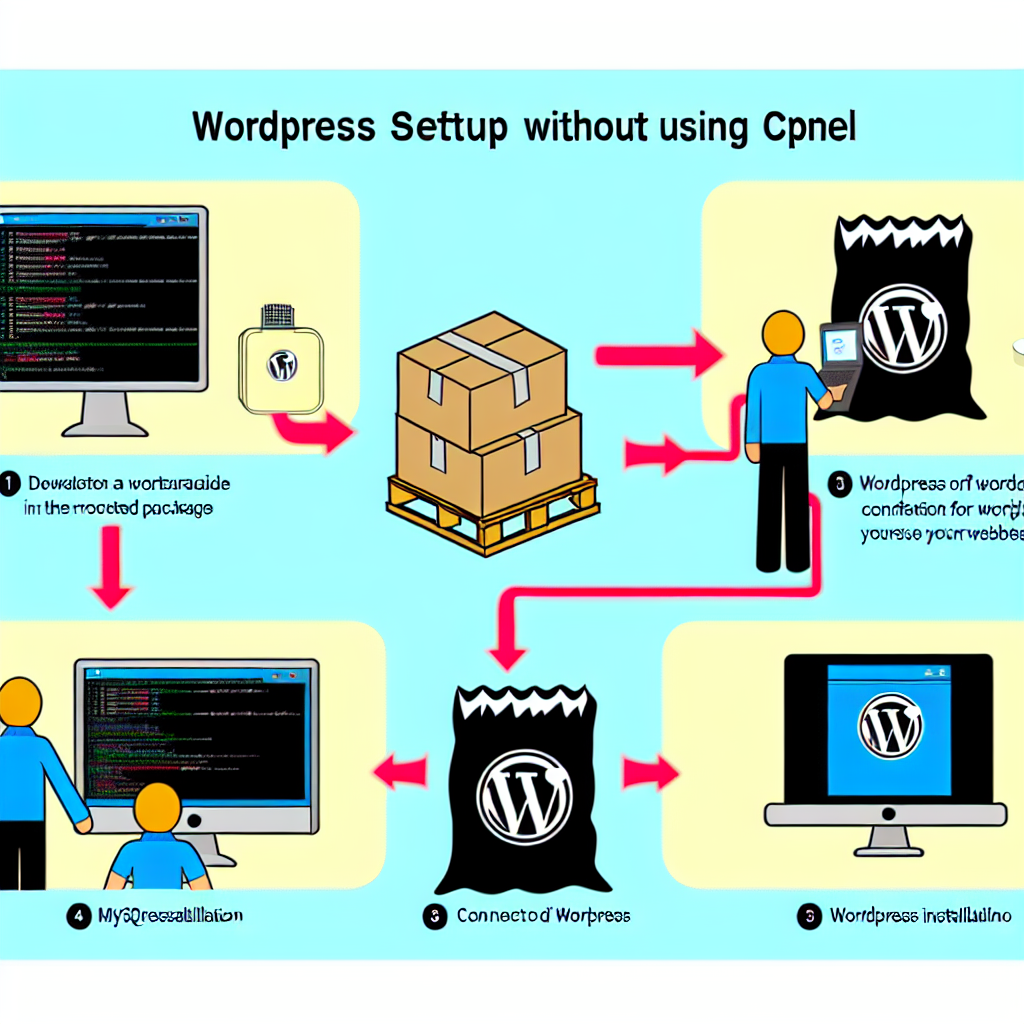### Quick Tips for WordPress Hosting Setup
In today’s digital age, launching your own website has never been easier, especially if you want to start a WordPress website without cPanel. Many users are familiar with cPanel as a popular hosting management tool, but did you know that you can set up your WordPress site without it? Whether you’re a seasoned developer or a complete beginner, this article will guide you through the process and highlight the benefits of bypassing traditional cPanel hosting. By understanding the essential steps and advantages of a cPanel-free setup, you’ll be well on your way to creating a successful online presence. Let’s dive in and explore how you can efficiently start your WordPress website without cPanel.
- Here are three possible section headlines for your article on how to start a WordPress website without cPanel:
- 1. **Understanding WordPress Hosting: Start Your Website Without cPanel**
Here are three possible section headlines for your article on how to start a WordPress website without cPanel:
## Quick Tips for WordPress Hosting Setup
Starting a WordPress website without cPanel might seem daunting at first, but it’s entirely possible with the right approach. Many website owners find cPanel to be a convenient tool, but there are effective alternatives that can streamline your website setup process. In this article, we will explore how to start a WordPress website without cPanel, guiding you through the essential steps to get your site live and thriving.
### Understanding Your Hosting Options
When you decide to start a WordPress website without cPanel, you first need to choose a hosting provider that offers alternative management tools. Here are some popular options:
– **Managed WordPress Hosting**: Services like WP Engine and Kinsta provide specialized hosting optimized for WordPress, with user-friendly dashboards.
– **VPS Hosting**: Providers like DigitalOcean or Linode allow you to manage your server directly, giving you full control over your environment.
– **Cloud Hosting**: Platforms like Amazon Web Services (AWS) or Google Cloud provide scalable solutions that can be customized to your needs.
### Step-by-Step Guide to Starting Your WordPress Website
1. **Select a Domain Name**: The first step is to choose a domain name that reflects your brand. Use domain registrars like Namecheap or GoDaddy to secure your domain.
2. **Choose a Hosting Provider**: As mentioned earlier, select a hosting provider that doesn’t rely on cPanel. Look for features such as one-click WordPress installation, SSL certification, and reliable customer support.
3. **Install WordPress Manually**:
– Download the latest version of WordPress from the official website.
– Upload the WordPress files to your server using an FTP client like FileZilla.
– Create a MySQL database and user via your hosting provider’s dashboard.
– Configure the `wp-config.php` file with your database details.
– Run the WordPress installation by visiting your domain.
4. **Customize Your Site**:
– Choose a theme that aligns with your brand.
– Install essential plugins for SEO, security, and performance.
– Create key pages such as Home, About, and Contact.
5. **Launch Your Site**: Once you’ve completed your setup and are satisfied with your content, it’s time to go live! Announce your new website on social media and through email marketing to drive initial traffic.
### Benefits of Starting a WordPress Website Without cPanel
– **Greater Control**: By not relying on cPanel, you gain more control over your hosting environment, allowing for custom configurations.
– **Learning Opportunities**: Managing a WordPress website without cPanel can enhance your technical skills, giving you a better understanding of how web hosting works.
– **Potential Cost Savings**: Some hosting providers may offer more competitive pricing without cPanel, helping you save money.
### Conclusion: Take the Next Step in Your WordPress Journey
Starting a WordPress website without cPanel is not only feasible but can also be a rewarding experience. By following the steps outlined above, you can create a robust online presence tailored to your needs. Don’t let the lack of cPanel intimidate you; embrace the challenge and expand your skills.
Ready to launch your WordPress website? Take action today and explore the hosting options that suit you best. For more tips and resources, subscribe to our newsletter or visit our blog for further insights into WordPress management and optimization!
1. **Understanding WordPress Hosting: Start Your Website Without cPanel**
### Quick Tips for WordPress Hosting Setup
Are you eager to start a WordPress website without cPanel? You’re not alone! Many aspiring website owners are looking for efficient methods to set up their online presence without the complexities of traditional hosting panels like cPanel. In this article, we’ll explore how you can effortlessly start your WordPress website without cPanel, providing you with actionable insights and tips to get your site up and running smoothly.
#### Understanding WordPress Hosting: Start Your Website Without cPanel
When considering how to start a WordPress website without cPanel, it’s essential to understand the basics of WordPress hosting. WordPress is a powerful content management system (CMS) that allows users to create and manage websites with ease. However, hosting your WordPress site doesn’t always have to involve cPanel, a popular but often complicated control panel used by many web hosting providers.
Here are some alternatives and strategies to consider:
– **Managed WordPress Hosting**: This option is specifically designed for WordPress users and often includes one-click installations, automatic updates, and enhanced security features. Managed hosting providers typically don’t require cPanel, simplifying the setup process.
– **Using FTP/SFTP**: If you prefer a hands-on approach, consider using File Transfer Protocol (FTP) or Secure File Transfer Protocol (SFTP) to upload your WordPress files to your server. You can use software like FileZilla to connect to your server and transfer files without needing cPanel.
– **Command Line Interface (CLI)**: For tech-savvy users, utilizing the WordPress Command Line Interface (WP-CLI) offers a powerful alternative to cPanel. With WP-CLI, you can manage your WordPress installation directly from the command line, handling everything from installations to updates.
– **Local Development Environments**: Tools like Local by Flywheel or XAMPP allow you to set up WordPress on your local machine without the need for cPanel. After building your site locally, you can migrate it to a live server when you’re ready.
#### Steps to Start Your WordPress Website Without cPanel
1. **Choose a Hosting Provider**: Look for a hosting provider that supports WordPress installations without cPanel. Managed WordPress hosts are often the best choice.
2. **Select a Domain Name**: Choose a domain name that reflects your brand and is easy to remember.
3. **Install WordPress**: Use your hosting provider’s alternative installation methods, such as one-click installs or WP-CLI, to set up WordPress on your server.
4. **Configure Your Site**: Once installed, log in to your WordPress dashboard and begin customizing your site’s settings, themes, and plugins.
5. **Launch Your Site**: After designing your website and adding content, it’s time to go live! Ensure everything is working correctly before announcing your new site to the world.
#### Conclusion
Starting a WordPress website without cPanel is not only possible but can also be a more straightforward experience when you understand your options. Whether you choose managed hosting, FTP, CLI, or local development, there are plenty of ways to get your site up and running efficiently.
Ready to take the plunge and start your WordPress journey? Explore the hosting options mentioned above and find the method that best suits your needs. For more tips and guidance on website creation, be sure to check out our other articles and resources. Don’t wait—start your WordPress website today!
## Quick Tips for WordPress Hosting Setup
Starting a WordPress website can be an exciting venture, but many new users often feel overwhelmed by the technical requirements. If you’re looking to **start a WordPress website without cPanel**, you’re not alone. This article will guide you through the essential steps and alternative methods to get your site up and running smoothly, all without the need for cPanel.
### Why Choose to Start a WordPress Website Without cPanel?
Using cPanel can simplify the management of your website, but there are several reasons you might opt to bypass it:
– **Cost-Effective Alternatives**: Some hosting providers offer platforms that do not require cPanel, potentially saving you money.
– **Simplified Management**: Many hosting providers offer user-friendly interfaces that can be easier to navigate than cPanel.
– **Increased Flexibility**: Without cPanel, you can choose to use different tools and applications that better suit your needs.
### Steps to Start Your WordPress Website Without cPanel
#### Step 1: Choose a Hosting Provider
Select a hosting provider that allows you to install WordPress without cPanel. Here are a few popular options:
1. **Managed WordPress Hosting**: Providers like WP Engine or Kinsta offer one-click installations and specialized support for WordPress.
2. **Cloud Hosting**: Services like DigitalOcean or AWS enable you to set up a WordPress instance without traditional control panels.
3. **Website Builders**: Platforms such as Wix or Squarespace allow you to create WordPress-like sites without needing backend access.
#### Step 2: Install WordPress Manually
Once you’ve chosen your hosting provider, you can install WordPress manually. Here are the steps:
1. **Download WordPress**: Go to the official WordPress website and download the latest version.
2. **Upload Files**: Use an FTP client (like FileZilla) to upload the WordPress files to your server.
3. **Create a Database**: Access your hosting dashboard (even if it’s not cPanel) to create a MySQL database and user.
4. **Configure wp-config.php**: Edit the `wp-config.php` file with your database details.
5. **Run Installation**: Navigate to your domain to complete the WordPress installation by following the on-screen instructions.
#### Step 3: Customize Your Website
After installing WordPress, it’s time to customize:
– **Choose a Theme**: Select a responsive WordPress theme that suits your brand.
– **Install Essential Plugins**: Consider plugins for SEO, security, and performance optimization. Popular choices include:
– Yoast SEO
– Wordfence Security
– WP Super Cache
#### Step 4: Launch Your Website
Before launching, ensure you:
– Test all links and functionality.
– Optimize for SEO using best practices.
– Set up Google Analytics to track your site’s performance.
### Tips for Maintaining Your WordPress Website
– **Regular Backups**: Use plugins or your hosting provider’s tools to back up your content regularly.
– **Update Themes and Plugins**: Keep everything updated to ensure security and performance.
– **Monitor Performance**: Use tools like Google PageSpeed Insights to analyze and improve site speed.
### Conclusion
Starting a WordPress website without cPanel is not only possible but can also offer you more control and flexibility. By following the steps outlined in this article, you can successfully launch your site and manage it effectively. Ready to get started? Take action today and explore the various hosting options available to kick off your WordPress journey! For more insights and tips on website management, feel free to reach out or explore our other resources.

